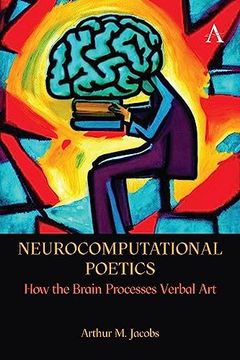Compartir
Neurocomputational Poetics: How the Brain Processes Verbal art (Anthem Studies in Bibliotherapy and Well-Being) (en Inglés)
Jacobs Arthur (Autor)
·
Anthem Press
· Tapa Dura
Neurocomputational Poetics: How the Brain Processes Verbal art (Anthem Studies in Bibliotherapy and Well-Being) (en Inglés) - Jacobs Arthur
$ 126.53
$ 253.06
Ahorras: $ 126.53
Elige la lista en la que quieres agregar tu producto o crea una nueva lista
✓ Producto agregado correctamente a la lista de deseos.
Ir a Mis Listas
Origen: España
(Costos de importación incluídos en el precio)
Se enviará desde nuestra bodega entre el
Miércoles 19 de Junio y el
Lunes 01 de Julio.
Lo recibirás en cualquier lugar de Ecuador entre 1 y 3 días hábiles luego del envío.
Reseña del libro "Neurocomputational Poetics: How the Brain Processes Verbal art (Anthem Studies in Bibliotherapy and Well-Being) (en Inglés)"
This book introduces a new thrilling field-neurocomputional poetics, the scientific 'marriage' between cognitive poetics, data science and neuroscience. Its goal is to uncover the secrets of verbal art reception and to explain how readers come to understand and like literary texts. For centuries verbal art reception was considered too subjective for quantitative scientific studies and still nowadays many scholars in the humanities and neurosciences alike view literary reading as too complex for accurate computational prediction of the neuronal, experiential and behavioural aspects of reader responses to texts. This book sets out for changing this view. It offers state-of-the-art computational models and methods allowing to predict which crucial textual features of prose and poetry, such as syntactic and semantic complexity or emotion potential, interact with reader features, such as empathy or openness to experience, in shaping a literary reading act. It contains hands-on practical examples on how to do computational text analyses of books and poems that can answer questions like: Which is Jane Austen's most beautiful book? Which poet created the most fitting poetic metaphors? or Which author of plays of the nineteenth century was the most literary? The book's first chapter about 'The Two Boons of an Unnatural Daily Activity' discusses the neuronal bases and other relevant aspects of immersive and aesthetic processes evoked by reading prose and poetry. In the second chapter, the author introduces a comprehensive model of verbal art reception that can explain what makes texts comprehensible and likeable and how they affect our body and mind. The model makes explicit important differences between the reading of prose and poetry and clarifies which text features make prose more immersive and poetry more aesthetic. The next two chapters discuss state-of-the-art methods for quantitative text, reader and reading act analyses from cognitive poetics, data science, psychology and neuroscience and shows how they can be used to dissect the complex author-text-reader nexus that shapes verbal art reception. Chapters 5 and 6 then present hands-on practical examples on how to do simple and sophisticated computational text analyses including sentiment and topic analyses, cutting-edge machine learning methods, and multivariate predictive modeling using neural nets. Chapters 7 and 8 of the book then present a representative sample of empirical studies in both computational and neurocognitive poetics the author and his collaborators have carried out during the last decade. The results of these studies provide comprehensive insights into the complex workings of the brain during verbal art reception from the processing of single words and sentences to the aesthetic evaluation of metaphors or entire poems and novels, including a qualitative-quantitative analysis of the reading of Shakespeare sonnets that will change the ways of scientific studies of literature. The book ends with a short chapter about conclusions and future developments. The model and methods introduced in the book offer game-changing insights for both fundamental and applied science that will affect standard metrics of readability and the way text processing and verbal art reception are viewed in literary studies, education, psychology or the media sciences.
- 0% (0)
- 0% (0)
- 0% (0)
- 0% (0)
- 0% (0)
Todos los libros de nuestro catálogo son Originales.
El libro está escrito en Inglés.
La encuadernación de esta edición es Tapa Dura.
✓ Producto agregado correctamente al carro, Ir a Pagar.

